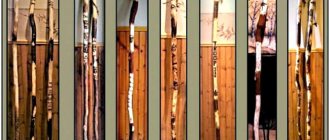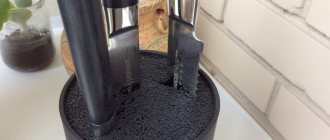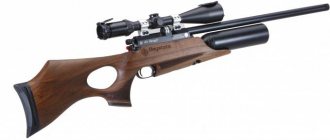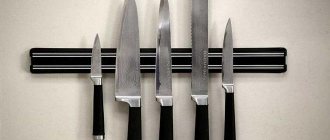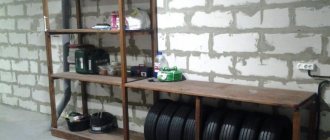We recently figured out what is the best knife handle
. There we came to the conclusion that although high-quality synthetics are better, wood looks much more aesthetically pleasing. If you properly impregnate a piece of wood, it will last for decades, and will even be passed on to your children.
So today we will tell you about the types of wood most often used to make knife handles. In general, the “correct” handle is the key to the success of any knife. It doesn’t matter what kind of steel it is made of, the most important thing is that it fits well in the palm of your hand and you can work with it comfortably.
Birch
The cheapest and most readily available material for making knife handles. Getting such a piece of wood is as easy as shelling pears - just go to any hardware store and buy a birch cutting for a shovel. This will save you from the work of selecting, drying and preparing wood. From what I can immediately remember with a simple wooden handle, these are Mora Classic knives.
Birch is perfectly processed and does not split under shock loads. This does not mean that you need to hammer in nails with a birch handle; not a single wooden handle can withstand such abuse. Our Russian knife makers very rarely use simple birch to make knife handles. At a minimum, it is Karelian, but most often it is birch burl or suvel.
What to make a knife handle from: Wood. Part 1.
Wood, along with horn, was the first material that people began to use in making knives. Over several millennia, a sustainable technology for working with wood has been developed, and all possible methods of wood processing have been tried. And although today wooden handles compete with modern materials such as micarta, G-10 or carbon, the relevance of their use does not decrease. Wood, especially wood that has undergone modern processing, continues to be actively used in the production of handles; not only long-known wood species are used, but also quite exotic, rare and possessing interesting properties. 1. Hornbeam Hornbeam
(lat. Cárpinus) is a genus of small deciduous trees from the Birch family (Betulaceae). Hornbeams grow in the northern hemisphere, Asian countries and China. Only two species are known in Europe.
Hornbeam is a slow growing tree. The color of the wood in section is whitish-gray. The average density of hornbeam wood in a dry state is 750 kg/m3. Hornbeam wood is very hard and difficult to process with tools. Requires slow drying and at the same time dries out greatly in volume. Hornbeam wood is used where high hardness, toughness, and resistance to impact loads are required. At the same time, poorly processed hornbeam can rot, while overdried hornbeam actively cracks. Often used for handles of hand tools and various sports equipment (billiard cues, golf clubs). For knife handles it is most often used in stained form. Bog hornbeam, impregnated with resins, is less susceptible to cracking, but does not tolerate high humidity. In case of insufficient processing, during use it may change color to a paler one or the wood may begin to raise pile. These are signs that the handle should be further soaked in oil. For these purposes, teak, linseed, tung and other oils are used. Impregnation occurs at temperatures up to 60° C and with the handle completely immersed in oil.
Traditionally, Russian manufacturers paint hornbeam black and, if properly treated, it can last for many years. 2. Karelian birch
Karelian birch (oral “Korelian birch”) is the wood of a variety of silver birch (lat. Betula pendula var. carelica), which has thickenings on the trunk (burl) and a patterned twisted wood texture.
Karelian birch is a deciduous tree, reaching 15-20 m in height. The trunk diameter reaches 40 cm. It grows in the western part of Norway and Sweden, in the southeast of Karelia, in the Baltic countries, Poland and Belarus. The bark is white with large tubercles called “svili”. The strands form a specific type of wood in which part of the bark remains inside the thickening and a characteristic pattern is created. Birch trees reach their maximum tortuosity when they are 5-6 years old.
Karelian birch is an anomaly caused by the “pitting syndrome” of the stem, that is, the appearance of a special “ribbing” on the trunk and is therefore relatively rare in nature. The pattern of Karelian birch wood is created as a result of the pathology of the functioning of the cambium. The anomaly manifests itself in a large accumulation of parenchymal (elongated and pointed at the ends) cells in the thickness of the wood, which create an original pattern. Birch wood has a beautiful pattern, durability (hard and non-fragile material), and produces beautiful colors in the finish - dark brown inclusions on a light yellow background. Karelian birch wood has high viscosity and density of 750-770 kg/m3. It does not crack upon impact and is well tinted and painted.
In order to prevent rotting and maximize strength, Karelian birch is impregnated with special solutions to improve its performance properties. Wood stabilized in this way does not lose color under the influence of ultraviolet rays, becomes more resistant to moisture and acquires a structure close to stone. Various substances are used as stabilizing impregnation, for example polymethyl methacrylate (plexiglass) or cyanoacrylate (instant adhesive). Cyanoacrylate is easily absorbed into wood and polymerizes after a short time due to the evaporation of the solvent from the composition and due to contact with atmospheric oxygen. In industrial enterprises, it uses two-component epoxy resins of high fluidity, such as duromeroplast or acrylic. For impregnation, special high-pressure installations up to 200 atmospheres are used. Another method of processing birch is the “wet calcination” method, during which the tree is boiled for several hours, after which it is sent for drying. When drying, the wood is kept for two hours at a temperature of 90°C, and then the temperature is raised to 140-200°C for 40-60 minutes. As a result of processing, it acquires increased density, dimensional stability, water resistance and strength. Handles made of stabilized Karelian birch acquire different colors as a result of impregnation: emerald, orange, chocolate, dark blue, green, light pink, etc.
3. Arizona Ironwood
Desert ironwood (Olneya tesota) is a monotypic plant species of the genus Olneya of the subfamily Faboideae of the Fabaceae family. It grows in the deserts of the states of Arizona and California (USA), as well as the Mexican states of Baja California, Baja California Sur and Sonora. In Arizona, the tree is found at altitudes up to about 600 m, often found in dry river beds. Ironwood is sensitive to cold - mature trees die at -6...-9 °C, but copes well with very dry places.
Arizona ironwood sinks in water and is very dense, durable and heavy. Its structure does not allow for traditional stabilization with oils. The wood is not brittle and does not crack. Wood density is 1000-1200 kg/m³.
The color of the heartwood varies from orange-yellow to darker red or brown, with darker purple and black stripes. Some areas may be almost completely black. Narrow yellow sapwood (outer young, physiologically active layers of wood of trunks, branches and roots, adjacent to the educational tissue - cambium), is clearly separated from the core of the tree. Wood gives a natural shine. It sharpens, varnishes and polishes well. Typically, ancient ironwood trunks are used for knife handles, which are found under a layer of desert sand. When processing ironwood, it is important to avoid overheating the wood, otherwise cracks may form. The surface is usually sanded with fine-grained paper, without using polishing wheels, as this will cause the surface to become uneven.
4. Walnut
Walnut (lat. Júglans régia) is a species of tree of the genus Walnut of the Walnut family (Juglandaceae). Large tree up to 25 m tall. The thick trunk is covered with gray bark, the branches form an extensive crown with a diameter of about 20 m. The average lifespan of a tree is 250-350 years. Walnut wood is considered a valuable species. In the wild state, the walnut grows in Transcaucasia, especially in the western part, as well as in the Talysh Mountains, in addition it grows in northern China, northern India, the Tien Shan, Iran, Asia Minor, the Balkans, Ukraine, southern Russia and Greece.
The nut breed is sound. The sapwood is separated from the core by clear lines. The sapwood is gray in color, sometimes with reddish patches. The core is dark. Brown or gray tint. The radial section of the trunk has a peculiar striped pattern.
Due to the uneven shade of the heartwood, combined with the patterns of walnut wood, walnut wood has a complex, beautiful texture. Walnut is a hard wood with high strength, resistance to decay and resistance to environmental factors. The natural color of a walnut knife handle is close to oak, but without the green tint. Over time, the walnut handle darkens a little and acquires a grayish-brown tint. Walnut wood has high decorative properties.
It is resistant to moisture, easy to polish, paint and varnish. For nuts, the drying regime is extremely important. When drying quickly, the wood becomes deformed and warped. But when dried, it becomes wear-resistant and does not change shape. Such handles can serve for many years and can be used on knives for a wide range of applications.
5. Wenge
Wenge (lat. Millettia laurentii) is a species of African tropical trees from the genus Millettia, legume family. The tree grows up to 20 m in height and 1 m in diameter.
In addition to wenge, the plant is known by many other names: Congolese rosewood, African rosewood, Congolese rosewood, African rosewood, etc. The tree mainly grows in the tropical jungles of West Africa, mainly in the Democratic Republic of the Congo, as well as in the Republic of Congo, Cameroon, Gabon, Equatorial Guinea, Tanzania and Mozambique. The related species Milletia stuhlmannii is found in East Africa and is locally called panga panga. These breeds are similar in appearance and properties.
Wenge is a heavy, hard and pressure-resistant wood. Dry density is about 880 kg/m³. Has good resistance to fungi and insects. The dark and very dense wood of the heartwood is important and is an important material due to its properties and beautiful color and texture. The color of mature wood is golden brown to very dark brown with black veining. The pores of wood contain many mineral and oily substances, which make processing difficult, including varnishing. Therefore, waxing is mainly used to process wenge. Wenge wood is quite difficult to polish. Dries slowly and may crack. Has high resistance to impact and bending. It is highly resistant to rotting.
Fruit trees
Good handles are made from apple, pear, cherry or plum. But it’s not worth cutting down fruit trees to make knife handles out of them. But if you need to cut down a bad or non-fruit-bearing tree on your site, then it would be a sin not to use such good, and most importantly free, material. As a last resort, you can cut the wood into blanks and sell it to knife makers.
Deciduous trees growing in our latitudes
We will not consider each tree separately, as this will take too much time. Let’s just list the tree species that our knife makers most often use:
- Oak. Bog oak is most prized;
- Rowan;
- Ash;
- Sea buckthorn;
- Beech;
- Acacia.
This is not a complete list of trees that can be used to make knife handles. The most valuable thing in any wood is the root, the root cut, all sorts of burls and burls.
Stabilized hornbeam
This is generally a cool tree that can perfectly replace ebony. Hornbeam wood is impregnated with resins and becomes black. Stabilized hornbeam handles are very strong, it’s not for nothing that the British called hornbeam ironwood. Stabilized hornbeam bars are inexpensive, approximately at the same level as Caucasian walnut bars.
Eben
One of the most expensive types of wood in the world. The average age of wood maturation is 500-600 years. The most valuable is Ceylon ebony, which is black in color. The wood of this tree is hard and dense, with practically no pores. When cutting down ebony, the bark and sapwood, which makes up about 70% of the trunk, are removed from above. The remaining 30% is this very ebony tree.
For melting, prepare 40 bottle caps
The handle is made from PET bottle caps. You need a sufficient amount of them, about 30-50 pieces. A device for pouring - easily made from wood in the shape of a future handle; 3-4 clamps are needed to fix its position. Baking paper.
DIY electronics in a Chinese store.
Sapale
Another African type of wood, distinguished by its red tint. It has high hardness; knife handles made of this material are not subject to cracking.
In addition to solid wooden handles, craftsmen often combine different types of wood. Such handles often look more original, although it’s not always the case. The same “snake tree” looks much better in the form of a solid handle.
Handles made of birch bark can also be classified as wood.
. This is an excellent material that is not subject to rotting, does not chill your hand in the cold and does not need impregnation.
Knife handle: characteristics and properties
The design of any knife is extremely simple, because it consists directly of a blade (blade) and a handle. When purchasing, we most often pay attention to the material, sharpness and shape of the blade, leaving the handle without attention. This approach is incorrect, since an awkwardly shaped handle can nullify all other advantages of the product.
Figure 1. The shape of the handle directly affects the ease of use of the knife.
The ease of use of the knife, its maneuverability and operational efficiency will depend on the correctly selected shape and size of the handle. The selection of materials also plays an equally important role. For example, if you are going to use the tool primarily outdoors, it is better to choose a product with a handle made of durable and wear-resistant material - deer antler, wood or plastic. For home use, knives with handles made of plywood and other lightweight materials are suitable, which will help you use the knife for a long time without fatigue (Figure 1).

